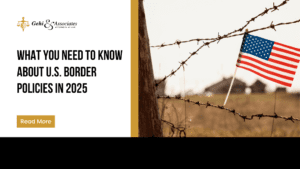The U.S. border policies in 2025 have undergone a dramatic transformation, reshaping immigration and affecting millions of people. The system is now stricter and more complex than in previous years. There are new executive orders, increased deportations, and shifting asylum regulations. There is a significant departure from the past administration’s approach. Marked by the reinstatement of policies, such as the “Remain in Mexico” program and the expansion of AI-driven border surveillance. These policies impact those seeking entry into the U.S. and affect industries, communities, and the broader economy.
For immigrants, the stakes are higher than ever. Asylum seekers from Central America and Africa face heightened scrutiny. State-level policies, particularly in Texas, create new legal battles over immigration enforcement. Meanwhile, businesses reliant on immigrant labor are experiencing workforce shortages, leading to economic uncertainty.
In cities like Queens, NY, with a vast immigrant population, the consequences of these changes are already being felt. A Queens Immigration Attorney helps immigrants and business owners stay informed about their rights and available legal options.
Key Statistics:
- Over 1,000 people were deported in a single day on January 23, 2025.
- The U.S. military has deployed 1,500 troops to the southern border.
- More than 500,000 immigrants from Cuba, Haiti, Venezuela, and Nicaragua have lost their humanitarian parole status.
- Nearly 270,000 migrants were stranded in Mexico when the CBP One app was shut down.
- ICE arrested 956 people in a nationwide raid on January 26, 2025.
- Texas alone has spent billions building its border wall and deploying its National Guard.
- The asylum backlog has surpassed 3.6 million cases, leading to unprecedented delays.
How State-Level U.S. Border Policies in 2025 Have Changed Compared to Federal Policies
State-level immigration laws in 2025 have increasingly diverged from federal policies, creating intense legal battles and uncertainty for immigrants. Federal agencies have reinstated programs like the “Remain in Mexico” policy. They have expanded expedited removals and escalated mass deportations. Meanwhile, states like Texas and Florida have introduced their own immigration laws.
Texas has taken the most aggressive stance. Implementing policies that allow state law enforcement to arrest and deport migrants independently of federal agencies. Cities with sanctuary policies, such as New York, Los Angeles, and Chicago, are now facing the threat of losing federal funding.
These policy shifts have widespread consequences. Affecting asylum seekers, undocumented immigrants, and even legal visa holders caught in enforcement efforts. The legal battles surrounding state and federal authority over immigration are ongoing. Leaving many uncertain about their rights and protections.
How Have Sanctuary Policies Changed?
Sanctuary cities, jurisdictions that limit cooperation with federal immigration enforcement, are under significant pressure in 2025. The present administration has reintroduced policies aimed at defunding cities that refuse to comply with ICE detainer requests. Placing many local governments in a difficult position.
The federal government’s strategy of financial pressure is proving effective in pushing some cities toward compliance. However, strong opposition from advocacy groups and local leaders suggests that the fight over sanctuary policies is far from over.
The growing divide between state and federal policies creates uncertainty and fear for immigrants. In states like Texas and Florida, migrants face an increased risk of state-led deportation efforts. Before they interact with federal immigration authorities. This has raised concerns about due process and the potential for racial profiling. With legal battles over state and federal immigration policies ongoing, immigrants must stay informed and use experienced legal assistance.
How U.S. Border Policies in 2025 Affect Asylum Seekers
Asylum seekers have been among the hardest hit by the new U.S. border policies in 2025. Restrictive measures have been reinstated and expanded. Significantly reducing pathways for asylum seekers to enter the U.S. legally.
The asylum backlog has surpassed 3.6 million cases, reaching an all-time high due to increased restrictions and delays. Court dates have been pushed back by years, leaving thousands of asylum seekers uncertain about their future.
Meanwhile, access to legal aid has become even more limited. Hence, advocacy groups struggle to keep up with the overwhelming number of new cases. These changes have had disproportionate impacts on asylum seekers from Central America and Africa. Two regions that historically faced some of the lowest asylum approval rates in the U.S.
Central American Asylum Seekers
Migrants from Central America have been particularly affected by the reinstated “Remain in Mexico” policy. The 2025 iteration of the policy has expanded the number of nationalities subject to the program. Making it even more difficult for Central Americans to receive asylum protection.
The expansion of expedited removals has further worsened conditions for Central American asylum seekers. Previously, migrants present in the U.S. for at least 2 weeks were entitled to an immigration hearing before deportation. Expedited removals now apply to anyone who cannot prove they have been in the U.S. for at least 2 years. This change has resulted in mass deportations of thousands of asylum seekers.
African Migrants’ Asylum Approval Rates
African asylum seekers have historically faced lower approval rates than migrants from other regions. The latest U.S. border policies have significantly reduced humanitarian protections for African migrants. One of the most significant changes affecting African asylum seekers is the termination of humanitarian parole programs.
These programs provided temporary legal entry for migrants fleeing war, political persecution, and humanitarian crises. Their removal has left thousands of African migrants stranded in legal limbo. The already low asylum approval rates for African migrants have worsened due to stricter vetting measures.
There have been expanded DNA testing requirements and biometric screenings. This disproportionately affects African asylum seekers who often lack official documentation from their home countries. The impact of these policies has been devastating. Many asylum seekers have been denied entry due to missing paperwork or delays in processing biometric data. Many asylum seekers are without legal assistance or access to humanitarian protections. As the situation unfolds, the fight for asylum rights remains a critical issue in the broader debate.
Immigration laws are evolving; make sure you know where you stand. Read more here.
The Economic Impacts of Stricter U.S. Border Policies in 2025 on Industries Relying on Immigrant Labor
Immigrant labor has long been the backbone of the U.S. economy, sustaining industries like agriculture, construction, and hospitality. However, the stricter U.S. border policies in 2025 are triggering labor shortages across these key sectors. Mass deportations are ramping up, work visa approvals are slowing, and state-led immigration crackdowns are expanding. Industries that depend on immigrant workers are now grappling with workforce instability, rising costs, and disruptions in production.
U.S. Agriculture Labor Shortage
The U.S. agriculture industry faces one of the most severe labor shortages in recent history. This is due to the escalation of border restrictions and deportations. Farms have long depended on immigrant labor, particularly seasonal workers, to sustain food production. The crackdown on unauthorized labor has also impacted food production.
Construction Workforce Decline
The construction industry is facing critical labor shortages. Thousands of undocumented construction workers have been detained in workplace raids or deported. Leaving employers struggling to find replacements.
As a result, contractors report delays in major projects, increased labor costs, and difficulty hiring skilled tradespeople. This labor shortage is particularly severe in cities experiencing rapid development, such as New York, Los Angeles, and Houston.
Impact on the Hospitality Industry
The hospitality industry, restaurants, and tourism-related businesses, are experiencing a workforce crisis under the new immigration policies. Many hospitality businesses rely on immigrant workers for essential roles. Including housekeeping, food service, and customer-facing positions. However, recent changes in border policy have made it harder for businesses to hire and retain these workers.
This decline in available workers has driven up wages in the hospitality sector, increasing operating costs for businesses. Some restaurants and hotels have responded by cutting hours, raising prices, or reducing services. This in turn affects consumer demand and local tourism economies.
Legal Barriers to Hiring Immigrants
The 2025 border policies have made it more difficult for businesses to legally hire foreign workers. Stricter E-Verify requirements have forced employers to increase scrutiny of workers’ immigration status. leading to more hiring delays and fewer available workers. The expansion of worksite audits has also resulted in more penalties for businesses found employing undocumented immigrants.
Many businesses that previously relied on immigrant labor are now exploring automation or outsourcing as alternative solutions. However, these transitions take time and investment, leaving immediate workforce shortages unresolved.
Do U.S. Border Policies in 2025 Address Advanced Surveillance and AI in Immigration Enforcement?
The role of technology in immigration enforcement has expanded dramatically with U.S. boarder policies in 2025. Artificial intelligence (AI), biometric data collection, and automated surveillance systems are becoming central to border security operations. The new administration has argued that these technologies improve efficiency, enhance national security, and reduce unauthorized immigration.
However, civil rights groups and immigration advocates have raised concerns about privacy violations and the potential for government overreach. From AI-powered drones patrolling the U.S.-Mexico border to facial recognition scans at airports. Immigration enforcement is now more reliant on technology than ever before
AI Border Security 2025
The use of AI in border enforcement has intensified. The U.S. Customs and Border Protection (CBP) are deploying technology. This includes AI-powered drones, automated license plate readers, and facial recognition. These systems are designed to track, identify, and flag individuals suspected of illegal crossings or fraudulent entry attempts.
AI and biometric surveillance in U.S. border policies in 2025 present opportunities and risks. Some technologies may improve efficiency in processing applications and reducing wait times. However, they also introduce new barriers, risks of misidentification, and increased surveillance.
The AI-driven risk assessment models may result in unfair denials for asylum seekers. This is due to automated systems lacking human judgment. Families applying for legal status may be subject to DNA testing and biometric collection. Further complicating an already difficult process.
Perhaps most concerning is the potential for long-term data retention. Immigrants who go through biometric screening may have their data stored indefinitely. Creating a permanent digital record that could be used against them in future policy changes. This is particularly alarming for DACA recipients, Temporary Protected Status holders, and asylum seekers. As they one day face policy shifts that put their status at risk.
As technology continues to shape immigration enforcement, the consequences of AI-driven policies will be felt for years to come. Immigrants must remain vigilant, understand their rights regarding data privacy, and seek legal counsel.
Find Your Path Forward in the Face of Stricter U.S. Border Policies in 2025
Families are being separated, and businesses are facing labor shortages. Entire communities are feeling the weight of these U.S. border policy changes in 2025. Now more than ever, securing legal guidance is essential. Increased ICE raids and employment verification crackdowns mean many individuals need urgent legal assistance. A Queens immigration attorney is your ally in these uncertain times. Our attorneys can help you understand your options, fight deportation orders, and secure legal status.
Contact us to schedule a free consultation today and get the legal protection and representation you deserve.





